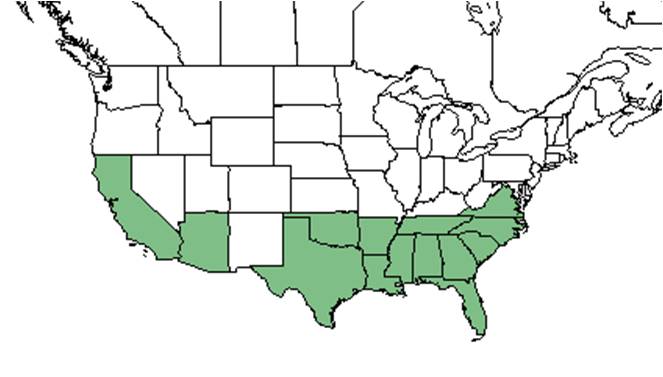Difference between revisions of "Gamochaeta calviceps"
KatieMccoy (talk | contribs) |
(→Distribution) |
||
| (20 intermediate revisions by 9 users not shown) | |||
| Line 15: | Line 15: | ||
| binomial_authority = (Lam.) Cabrera | | binomial_authority = (Lam.) Cabrera | ||
| range_map = gamo_falc_dist.jpg | | range_map = gamo_falc_dist.jpg | ||
| − | | range_map_caption = Natural range of ''Gamochaeta calviceps'' from USDA NRCS [http:// | + | | range_map_caption = Natural range of ''Gamochaeta calviceps'' from USDA NRCS [http://plants.usda.gov/core/profile?symbol=GAFA3 Plants Database]. |
}} | }} | ||
| − | Common name: | + | Common name: narrow-leaf purple everlasting |
| + | ==Taxonomic notes== | ||
| + | Synonyms: none<ref name=weakley>Weakley, A.S. 2020. Flora of the Southeastern United States. Edition of 20 October 2020. University of North Carolina at Chapel Hill, Chapel Hill, North Carolina.</ref> | ||
| + | |||
| + | Varieties: none<ref name=weakley/> | ||
| − | |||
| − | |||
==Description== | ==Description== | ||
<!-- Basic life history facts such as annual/perrenial, monoecious/dioecious, root morphology, seed type, etc. --> | <!-- Basic life history facts such as annual/perrenial, monoecious/dioecious, root morphology, seed type, etc. --> | ||
==Distribution== | ==Distribution== | ||
| + | This species' native range stretches east to Virginia, west to Texas, and south to Florida. It also occurs in South America. The plant has been introduced in California, Europe, and New Zealand.<ref name=weakley/> | ||
| + | |||
==Ecology== | ==Ecology== | ||
===Habitat=== <!--Natural communities, human disturbed habitats, topography, hydrology, soils, light, fire regime requirements for removal of competition, etc.--> | ===Habitat=== <!--Natural communities, human disturbed habitats, topography, hydrology, soils, light, fire regime requirements for removal of competition, etc.--> | ||
| − | This species has been observed to grow in in wet pastures and small depressional wetlands | + | This species has been observed to grow in in wet pastures and small depressional wetlands.<ref name=fsu>Florida State University Robert K. Godfrey Herbarium database. URL: http://herbarium.bio.fsu.edu. Last accessed: June 2014. Collectors: Cecil R Slaughter, Dianne Hall, and Kim Ponzio. States and Counties: Florida: Brevard.</ref> |
===Phenology=== <!--Timing off flowering, fruiting, seed dispersal, and environmental triggers. Cite PanFlora website if appropriate: http://www.gilnelson.com/PanFlora/ --> | ===Phenology=== <!--Timing off flowering, fruiting, seed dispersal, and environmental triggers. Cite PanFlora website if appropriate: http://www.gilnelson.com/PanFlora/ --> | ||
| − | It has been observed to flower and fruit in April | + | It has been observed to flower and fruit in April.<ref name=fsu/> |
| + | <!--===Seed dispersal===--> | ||
| + | <!--===Seed bank and germination===--> | ||
| + | <!--===Fire ecology===--> <!--Fire tolerance, fire dependence, adaptive fire responses--> | ||
| + | <!--===Pollination===--> | ||
| + | <!--===Herbivory and toxicology===--> | ||
| + | <!--===Diseases and parasites===--> | ||
| − | == | + | ==Conservation, cultivation, and restoration== |
| − | + | ||
| − | + | ==Cultural use== | |
| − | |||
| − | |||
| − | |||
| − | |||
| − | == | ||
==Photo Gallery== | ==Photo Gallery== | ||
| + | <gallery widths=180px> | ||
| + | </gallery> | ||
| + | |||
==References and notes== | ==References and notes== | ||
| − | |||
Latest revision as of 18:01, 26 May 2023
| Gamochaeta calviceps | |
|---|---|
Error creating thumbnail: Unable to save thumbnail to destination
| |
| Scientific classification | |
| Kingdom: | Plantae |
| Division: | Magnoliophyta - Flowering plants |
| Class: | Magnoliopsida – Dicotyledons |
| Order: | Asterales |
| Family: | Asteraceae ⁄ Compositae |
| Genus: | Gamochaeta |
| Species: | G. calviceps |
| Binomial name | |
| Gamochaeta calviceps (Lam.) Cabrera | |

| |
| Natural range of Gamochaeta calviceps from USDA NRCS Plants Database. | |
Common name: narrow-leaf purple everlasting
Contents
Taxonomic notes
Synonyms: none[1]
Varieties: none[1]
Description
Distribution
This species' native range stretches east to Virginia, west to Texas, and south to Florida. It also occurs in South America. The plant has been introduced in California, Europe, and New Zealand.[1]
Ecology
Habitat
This species has been observed to grow in in wet pastures and small depressional wetlands.[2]
Phenology
It has been observed to flower and fruit in April.[2]
Conservation, cultivation, and restoration
Cultural use
Photo Gallery
References and notes
- ↑ 1.0 1.1 1.2 Weakley, A.S. 2020. Flora of the Southeastern United States. Edition of 20 October 2020. University of North Carolina at Chapel Hill, Chapel Hill, North Carolina.
- ↑ 2.0 2.1 Florida State University Robert K. Godfrey Herbarium database. URL: http://herbarium.bio.fsu.edu. Last accessed: June 2014. Collectors: Cecil R Slaughter, Dianne Hall, and Kim Ponzio. States and Counties: Florida: Brevard.